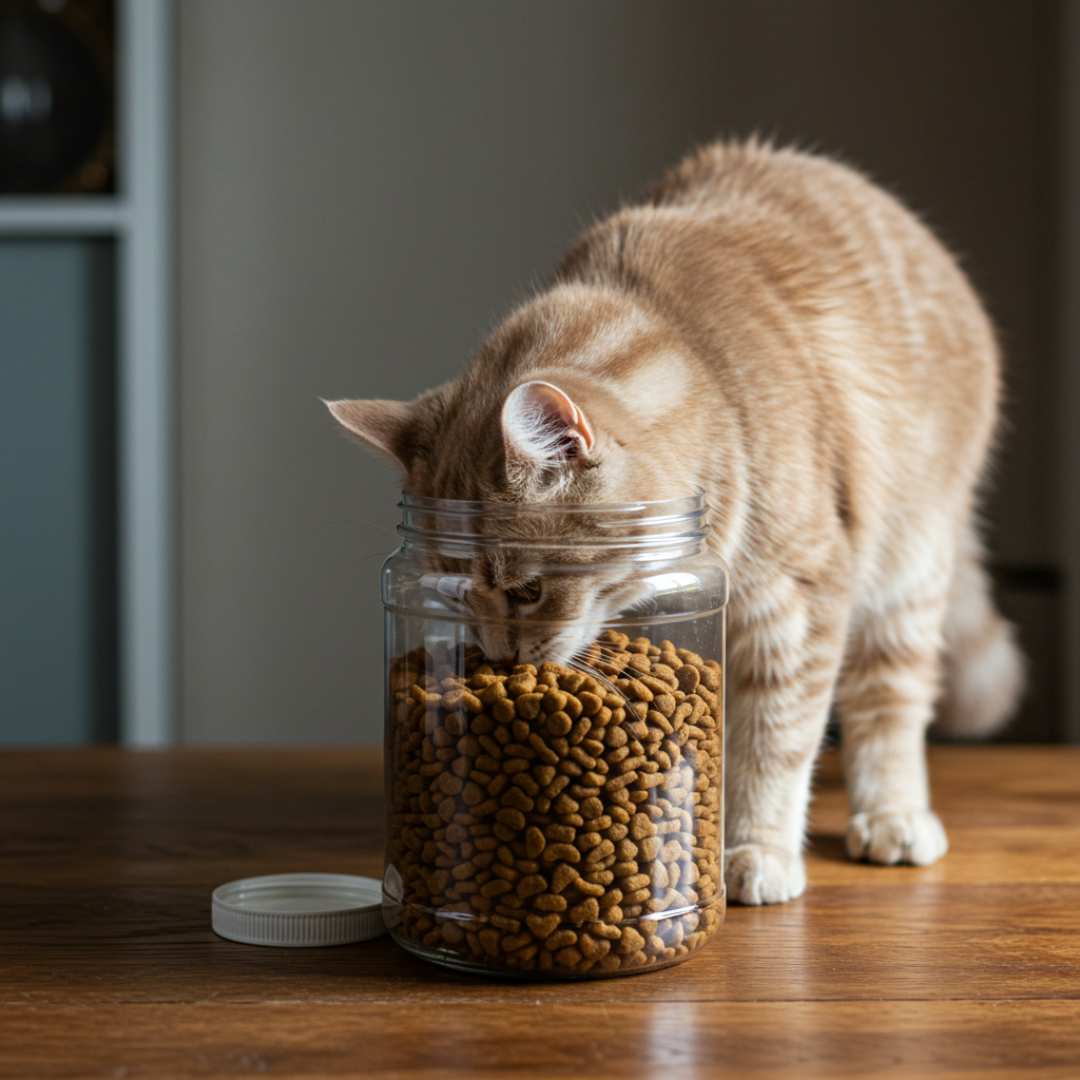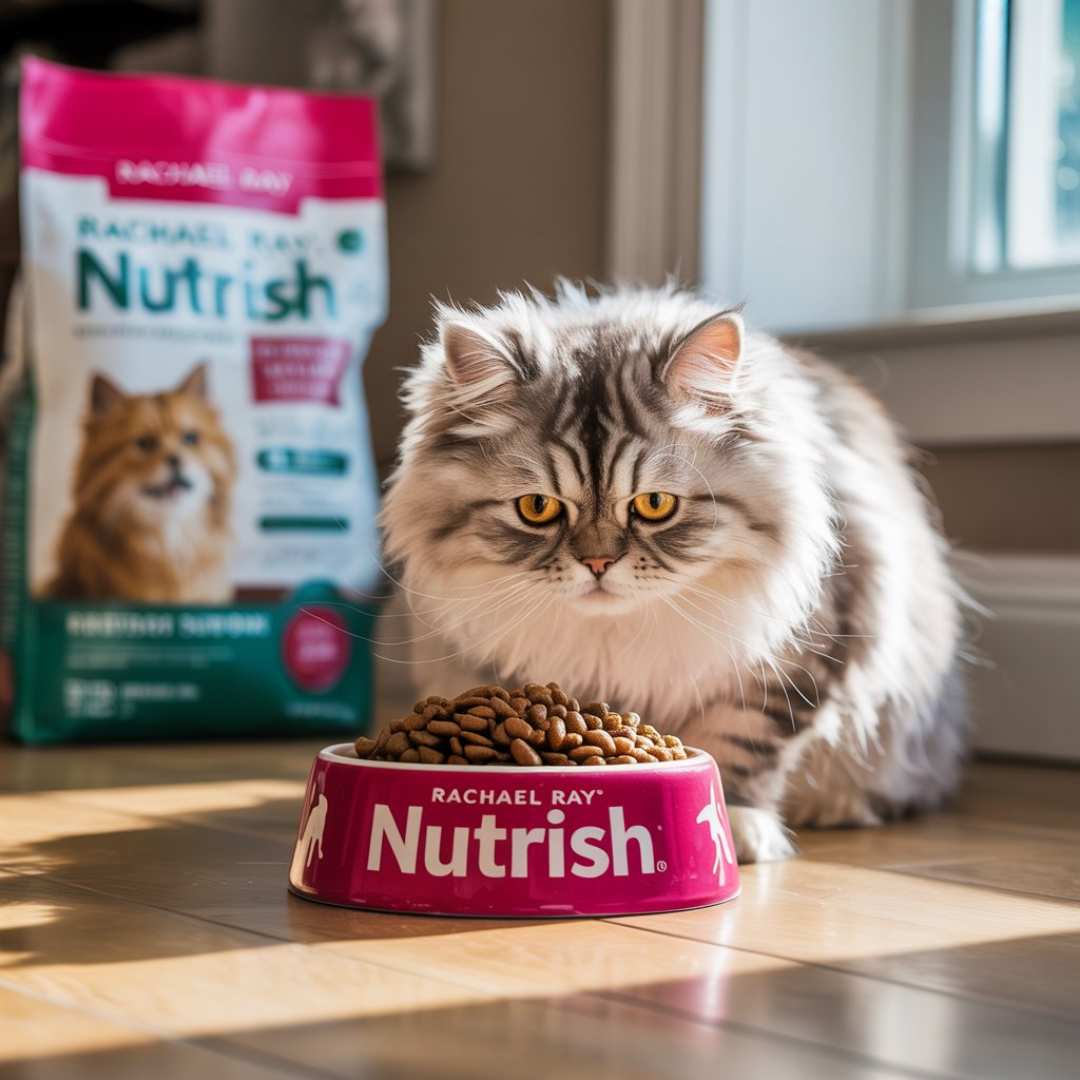Your question is: Can cats eat Rachael Ray dog food? The answer is no — cats should not eat Rachael Ray dog food. While eating dog food once is unlikely to cause immediate harm, feeding it to a cat long-term can lead to nutritional deficiencies because cats and dogs have different dietary requirements.
These deficiencies are particularly concerning for essential nutrients such as vitamin A and arachidonic acid. Additionally, some consumers have reported issues such as weight gain, digestive problems, and other serious health concerns when using certain pet food products.
Cat Food vs Dog Food Comparison
It may seem that dog and cat food look similar, but in reality, they are completely different.
Most cat foods contain higher levels of fat and protein than dog foods. They also have different requirements for essential fatty acids, essential amino acids, minerals, and vitamins.
According to the Association of American Feed Control Officials (AAFCO) nutritional profiles for adult cats and dogs, here are some of the key differences between cat and Rachael Ray Nutrish dog food:
| Nutrient | AAFCO Minimum for Adult Cats | AAFCO Minimum for Adult Dogs |
|---|---|---|
| Protein | 26% | 18% |
| Fat | 9% | 5.5% |
| Taurine Deficiency | 0.1% (dry food), 0.2% (canned food) | 0 |
| Arachidonic Acid | 0.02% | 0 |
| Vitamin A | 3332 IU | 5,000 IU/kg |
| Calcium | 0.6% | 0.5% |
Cats and dogs have very different nutritional needs. Dogs are omnivores, meaning they can get the nutrients they need from both plant and animal sources. Cats, however, are obligate carnivores, which means they rely solely on animal-based proteins to meet their nutritional requirements.
The most important thing is to ensure your pet eats a nutritionally balanced diet for cats suitable for their species, size, and life stage. For dogs, consider vet-recommended brands like Hill’s, Purina Pro Plan, and Royal Canin that meet AAFCO cat food standards.
Cats Can’t Eat Dog Food
Just because a cat occasionally nibbles on dog food doesn’t mean it will cause immediate harm. However, it’s not a good idea to intentionally feed your cat dog food — or your dog cat food.
Keep in mind that cats and dogs have different nutritional needs. Commercial cat and dog foods are specifically formulated with unique nutritional profiles to meet the distinct dietary requirements of each species.
“While there may be no immediate harm from occasionally consuming each other’s food, it’s especially important to feed pets a diet formulated specifically for their species to ensure they receive the right nutrients for long-term health,” explains Neves Torrent, DVM, veterinary nutritionist and Head of Innovation at Outdoor Bengal.
Cats are obligate carnivores, whereas dogs have developed a more omnivorous diet over thousands of years of domestication. Both species require protein, but cats and dogs have different needs for the essential amino acids that make up those proteins. Additionally, some vitamins are more easily absorbed by a cat’s body when they come from animal sources rather than plants.
“For example, cats require taurine deficiency, arachidonic acid, and preformed vitamin A — nutrients that may not be present in sufficient amounts in Rachael Ray Nutrish Dog Food,” says Dr. Torrent.
Commercial Rachael Ray cat food is typically formulated with higher levels of crude protein and dry matter compared to dog food.[Can cats eat dog food?] If a cat eats dog food as its main diet, it may not receive enough of these essential nutrients. Additionally, dog food often contains higher amounts of carbohydrates, which cats have a limited ability to digest.
Can You Feed a Cat Dog Food in a Pinch?

Life gets busy, and sometimes you just have to work with what you have. However, when it comes to emergency meals for dogs and cats, a simple swap shouldn’t be your go-to solution. In other words, you shouldn’t feed your cat dog food—or your dog cat food—just because their regular food isn’t available.
Let’s discuss what to do instead.
According to Greg Reinhart, PhD, vice president of research and development at Pet Integrity, cats can be offered cooked eggs or cooked meat on a short-term basis. “Remove any bones from the meat, and avoid using seasonings,” he advises.
For dogs: Offer a mix of carbohydrates and meat. CVA, DVM, Nell Ostermeier, FAAVA, recommends a ratio of one part grains and/or vegetables to two parts meat—for example, one cup of cooked chicken breast with half a cup of boiled rice.
If dog- or cat-appropriate ingredients aren’t available, a small amount of the other’s pet food may be used as a last resort.[Can cats eat dog food?] However, Dr. Torrent cautions that while cats may occasionally eat dog food, “cats may refuse or be uninterested in dog food.” She also emphasizes the importance of keeping a backup supply of pet food on hand to avoid such situations.
What If My Cat Eats Rachael Ray Dog Food?
If your cat is a curious eater, she may be tempted to sneak a bite from your dog’s bowl. Similarly, dogs, being food-motivated, might show interest in cat food. Is it bad for cats to eat dog food and vice versa?
The good news is that a few bites typically won’t cause serious harm. However, that doesn’t mean there’s no risk.
Depending on the amount of Rachael Ray cat food,” explains Dr.Reinhart, “a dog may experience feline digestive upset due to its high fat and protein content. Likewise, a cat eating dog food can also develop stomach discomfort, often from unfamiliar Rachael Ray dog food ingredients or a sudden change in diet.”
Whenever your pet eats something inappropriate—regardless of the species—it’s essential to monitor them for any negative reactions. Watch for signs of feline digestive upset, such as loose stools, vomiting, or diarrhea. If symptoms of malnutrition in cats persist for more than 24 hours or worsen, contact your veterinarian.
Commercial pet foods are generally not toxic to other pets, as many harmful ingredients overlap between dogs and cats. Still, it’s always wise to consult your veterinarian or call the Pet Poison Helpline to be safe.
How to Keep Your Cat Away from Dog Food
It can be as simple as switching one pet’s food or adjusting how and where you feed them. The solution usually depends on which pet is causing the problem.
As Dr. Reinhart points out, “Dogs are gluttons, while cats eat small portions throughout the day.” A little supervision at mealtime goes a long way in ensuring your dog finishes their own food before reaching for the cat’s bowl. For dogs who are particularly eager to sample cat food, simply placing the cat’s bowl out of their reach may be enough.
Dr. Reinhart offers some general tips for keeping pets away from each other’s food:
Provide cats with portioned meals using a dog-proof automatic cat feeder.
Keep cat bowls out of the dog’s reach or use elevated feeding stations.
Use pet doors or gates to restrict access to feeding areas.
Monitor mealtimes and remove uneaten portions of food.
If your pets are especially determined to sample each other’s meals and monitoring isn’t practical, consider using microchip feeders. These feeders recognize your pet’s implanted microchip or collar tag and only open for the correct animal, keeping other pets out.
Finally, don’t forget to store pet food properly between meals. Proper storage not only prevents unwanted snacking but also helps preserve the food’s flavor and nutritional value.
Is Rachael Ray Nutrish a Healthy Choice for Senior Cats?
Rachael Ray Nutrish offers some senior-formulated foods that may be suitable for many older cats. However, the health benefits depend on the specific Nutrish formula, your cat’s individual health status (such as diabetes, kidney disease, obesity, or dental problems), and pet food ingredient labeling/tolerance considerations. You should evaluate the product based on your cat’s medical needs rather than the brand name alone.
How to Decide on a Nutritious Food for a Specific Senior Cat
Check the Calorie Density and Guaranteed Analysis:
Protein: Senior cats generally need moderate to high-quality animal protein (≥30% dry matter basis).
Calories/Fat: Maintain body condition. High-calorie diets help underweight cats but may worsen obesity.
Fiber: Moderate fiber supports GI motility and helps control hairballs.
Inspect Rachael Ray Nutrish Ingredient Quality:
The primary animal protein should be listed early (e.g., chicken, turkey, or salmon). Avoid plant-heavy or filler-dominant diets.
Pay Attention to Specific Health Conditions:
Diabetes: Low-carb, high-protein canned food.
Dental Disease: Canned or softened kibble.
CKD (Chronic Kidney Disease): Moderate protein, low phosphorus, high moisture (canned preferred).
Weight Loss/Sarcopenia: High-protein, high-calorie, or prescription diets.
Phosphorus, Protein, and Taurine for Cats:
Ensure adequate cat food with taurine and B vitamins. Check sodium levels if kidney or heart problems are present.
Practical Steps to Make a Decision
Assess your cat’s health (lab results, body condition, and dental state).
Compare products against the above nutritional guidelines (calories, protein %, phosphorus/sodium, and Rachael Ray cat food ingredients).
Prioritize canned formulas for hydration and renal support.
Monitor weight, coat condition, appetite, litter box output, and lab results after switching.
Examples:
Healthy Seniors:[Can cats eat Rachael Ray wet dog food?] Nutrish wet food with named animal proteins and good protein content may be appropriate.
Early Kidney Disease: Choose a renal-support canned diet instead.
Overweight Seniors: Select a high-protein, lower-calorie wet food or use portion control.
When to Seek Veterinary Advice
If your cat shows appetite changes, weight loss, increased thirst or urination, vomiting, or chronic illness, consult your veterinarian and recheck lab work after switching diets.
Summary
[Can Cats Eat Rachael Ray Nutrish Dry Dog Food] Rachael Ray Nutrish senior formulas can be a reasonable choice for many healthy senior cats, especially wet versions containing named animal proteins. For cats with diabetes, CKD, or dental problems, veterinary-prescription diets are preferred. Always tailor the diet to your cat’s specific health needs and monitor their condition after making any dietary changes.
Can Cats Eat Dog Food: Health Risks and Prevention Tips
Feeding cats Rachael Ray food is an inappropriate diet that can lead to digestive issues and nutritional imbalances. When cats eat dog food, they risk serious nutrient deficiencies—dog food lacks essential taurine deficiency symptoms in cats, arachidonic acid, and certain vitamins that cats require for optimal health. Common symptoms of malnutrition in cats include vomiting, diarrhea, and lethargy.
To prevent this, provide species-appropriate nutrition such as high-quality wet or freeze-dried cat food, and keep feeding areas separate to discourage cross-eating. If your cat frequently consumes dog food, consult your veterinarian for a health evaluation and behavioral guidance. Preventing access to dog food is key to avoiding long-term health complications.
History of Rachael Ray Nutrish Cat Food
[Can Cats Eat Rachael Ray Nutrish Dog Food] In 2008, celebrity chef Rachael Ray founded Rachael Ray Nutrish, a pet food brand inspired by her homemade recipes for her beloved pit bull, Isaboo. Collaborating with pet nutritionists at Ainsworth Pet Nutrition, Ray developed a line of nutritionally balanced dog food based on wholesome, real food ingredients.
Around the same time, she established Rachael’s Rescue, a charity supporting no-kill animal shelters. All of Ray’s personal proceeds from Nutrish were donated to this initiative, which was later renamed the Rachael Ray Foundation.
Rachael Ray Nutrish expanded into the cat food market in 2014, offering recipes formulated specifically for feline nutritional requirements. In 2018, the brand was acquired by The J.M. Smucker Company, and in 2023, Holdings Inc. purchased several pet food brands from Smucker, including Nature’s Recipe and Rachael Ray Nutrish.
Rachael Ray Nutrish Cat Food Recall History
As of March 2025, the FDA has documented one recall of Rachael Ray Nutrish cat food. [Can cats eat Rachael Ray wet dog food?] On June 4, Rachael Ray Nutrish Recall 2015, Ainsworth Pet Nutrition voluntarily recalled five varieties of Rachael Ray Nutrish wet cat food formulas due to potentially elevated levels of vitamin D toxicity in cats.
Excessive vitamin D poisoning can cause symptoms such as vomiting, diarrhea, increased thirst, and seizures in cats. The recall was linked to 11 reported illnesses, though no fatalities were reported.
Conclusion of Can Cats Eat Rachael Ray Dog Food
In conclusion, cats should not eat Rachael Ray dog food or any dog food in general. While a one-time incident of a cat eating dog food is unlikely to cause immediate harm, long-term feeding can lead to serious nutritional deficiencies that may even result in death. This is because dogs and cats have fundamentally different dietary requirements.
Although dog and cat foods may appear similar, their nutritional compositions are quite different. Cat food typically contains higher levels of protein and fat, along with specific nutrients such as taurine deficiency symptoms in cats, essential fatty acids, vitamins, and minerals that are crucial for feline health but not adequately present in dog food.
If you’d like to learn more about Rachael Ray cat or dog food, feel free to contact us or leave a comment below.
Q1.Is Rachael Ray Food Good for Cats?
Ans. Rachael Ray Nutrish cat food can be a decent option—but with some caveats. It features real meat as a primary ingredient and supports animal welfare charities through the Rachael Ray Foundation. However, some formulas contain plant-based fillers like corn gluten meal, which lowers their species-appropriateness rating due to the high plant content.
Additionally, certain wet food products were recalled in 2015 for elevated vitamin D levels, slightly affecting the brand’s overall recall Rachael Ray pet food history score.
Q2.Is It OK for Cats to Eat Dog Food?
Ans. Absolutely not. Dog food is not suitable for cats long-term because cats have distinct nutritional needs—especially for cat food with taurine, protein, and certain essential nutrients that dog food lacks.
While an occasional nibble isn’t usually dangerous, regular consumption can cause serious health issues such as feline heart disease, blindness, organ damage, and muscle weakness due to nutrient deficiencies. Cats are obligate carnivores and require a meat-based diet rich in protein and fat, which dog food does not adequately provide.
Q3.Is Rachael Ray Dog Food Safe for Cats?
Ans. No. Cats should never eat dog food regularly, as it lacks critical nutrients—particularly high-quality protein, fatty acids, and essential vitamins—that cats need to thrive. Long-term feeding of dog food can lead to malnutrition and severe health complications.
Although occasional ingestion is unlikely to cause immediate harm, it’s best to prevent it altogether to avoid long-term risks or potential fatal outcomes.
Q4.What Dog Food Is Safe for Cats?
Ans. No dog food is safe or nutritionally adequate for cats. Cats have specific dietary requirements as obligate carnivores, including amino acids like taurine and higher protein levels that dog food cannot supply.
A small, one-time ingestion is not usually an emergency, but regular feeding can cause nutritional deficiencies, health deterioration, and even death. Always feed your cat species-appropriate cat food to ensure balanced nutrition and long-term well-being.
Q5.What Cat Food Is Similar to Rachael Ray Nutrish?
Ans. Brands similar to Rachael Ray Nutrish include Purina Pro Plan, Fancy Feast, and Weruva, which offer affordable options with varied ingredient profiles. For more natural or protein-focused choices, consider Wellness, Instinct, or Tiki Cat, which emphasize real meat and fewer fillers.
When choosing a cat food, take into account your cat’s specific dietary needs, such as food sensitivities or preferences for wet vs. dry food, to ensure optimal health and satisfaction.

